TDS is a measure of the total dissolved solids in water. Understanding TDS is important because it helps to indicate water quality and safety.
Here, our water treatment experts have shared everything you should know about TDS and its role in drinking water.
Table of Contents
💡 What is TDS in Water?
TDS, or total dissolved solids, is a measure of the total concentration of dissolved substances in water.
TDS is expressed in parts per million (PPM) or milligrams per liter (mg/L) and provides an overall indication of the water’s quality.
Related: How Much TDS in Water Is Good for Health?

Types of TDS in Water
Some of the common substances that contribute to TDS in drinking water include:
- Aluminum
- Bicarbonates
- Calcium
- Chlorides
- Chlorine
- Copper
- Fluoride
- Herbicides
- Iron
- Magnesium
- Pesticides
- Potassium
- Sodium
- Sulfates
- Zinc
📥 How Does TDS Enter Water?
Water is considered a universal solvent because it picks up and absorbs impurities from its surroundings, which contribute to total dissolved solids (TDS).
Total dissolved solids may enter water from natural sources, like soils and plants, or as a result of human influence or activity, such as agricultural runoff, corroding pipes, alterations by water treatment facilities, and urban runoff.
The TDS concentration of a water source depends on a few factors, including:
- Geology and soil composition – The geological characteristics of an area, including the type of rocks and soil, can influence the TDS content in water.
- Water source – The origin of the water source, whether it’s surface water (rivers, lakes, etc.) or groundwater, can impact TDS.
- Water flow – Fast-flowing rivers are likely to have more sediment (and therefore more TDS) because they cause more disturbance to the rocks and soils they flow over.
- If/how the water is treated – Certain water treatment processes, such as adding chemicals for disinfection, can influence TDS levels, while filtration reduces or removes contaminants that contribute to TDS.
- The presence of fish – The presence of certain bottom-feeding fish, such as carp, can also disturb solids, vegetation, and sediments in water sources, increasing the water TDS level.
🧪 How To Measure Total Dissolved Solids in Drinking Water
Total dissolved solids (TDS) is measured in milligrams per liter (mg/L) or parts per million (PPM). Both measurements are exactly the same and are used interchangeably.

The best way to determine your TDS level is to use a digital TDS meter. Follow these steps:
- Fill a glass with water from your faucet.
- Switch your TDS meter on and follow the instructions to calibrate the device.
- Place the TDS meter into the glass of water. A digital reading will appear on the screen.
Compare your reading to the graphic below to determine whether or not your water’s TDS levels are low, acceptable, or high.
A TDS meter won’t tell you exactly which suspended impurities are present in your water. You can see which contaminants are affecting your drinking water quality by checking your most recent annual Water Quality Report for your area or conducting a water quality test.
📈 TDS Calculation Formula
If you use a reverse osmosis unit to treat your drinking water, you can calculate the percentage of TDS rejection and measure the effectiveness of the system’s performance.
Follow these steps:
- Fill a glass of tap water and measure the TDS with the TDS meter.
- Fill a glass with reverse osmosis water and test the water again, then note down the results.
- Work out the TDS rejection percentage with the following formula:
TDS % Rejection = [Tap Water TDS – RO Water TDS/ Tap Water TDS] X 100
For example, if your tap water TDS was 260 and your reverse osmosis water TDS was 20, you’d do the following sum:
260 – 20/260 x 100 = 92.3%
📉 What Are the Guidelines for TDS in Tap Water?
The secondary drinking water regulations, produced by the Environmental Protection Agency (EPA), advise that the maximum TDS levels in public drinking water should be below 500 PPM to prevent aesthetic effects including mineral deposits, coloration, staining, and salty taste
Good to Know: In 2003, the World Health Organization conducted a study to find out which TDS levels people prefer the most. 0 to 300 mg l/ppm of dissolved solids is the range that most people find to taste the best.
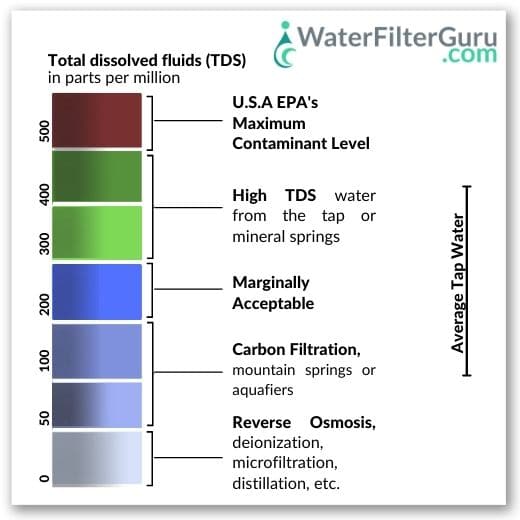
A TDS level above 1000 PPM is considered unsafe due to the possibility of certain substances being present in dangerous concentrations.
If your TDS levels are higher than 2,000 PPM/ milligrams per liter, then you will need to look into installing a specific water treatment system to reduce or remove TDS from your water.
The EPA only regulates municipal water, so if you own a private well, it’s your responsibility to reduce TDS to a safe concentration.
🤔 How Does TDS Affect Water Quality?
A water source’s TDS reading – aka its collective concentration of organic and inorganic materials – determines its quality and characteristics.
TDS can affect water quality in a few different ways:
- Aesthetic effects – Water with a high total dissolved solids concentration is likely to contain high concentrations of mineral ions, like calcium and magnesium, which make water hard and are responsible for scale formation in plumbing. It might also contain elevated levels of iron, tannins, and other substances that can stain surfaces and cause discoloration.
- Poor tastes – Additionally, elevated TDS may give water a slightly salty or bitter taste due to its high concentration of certain minerals. On the other end, water with a low TDS level has a “flat” or plain taste and can be corrosive.
- Health effects – While high TDS doesn’t always mean that harmful substances are present, there’s a higher likelihood that certain health-harmful contaminants (like toxic metals and chemicals) are present in dangerous concentrations.
👨🔧 Read about the difference between hard water and soft water
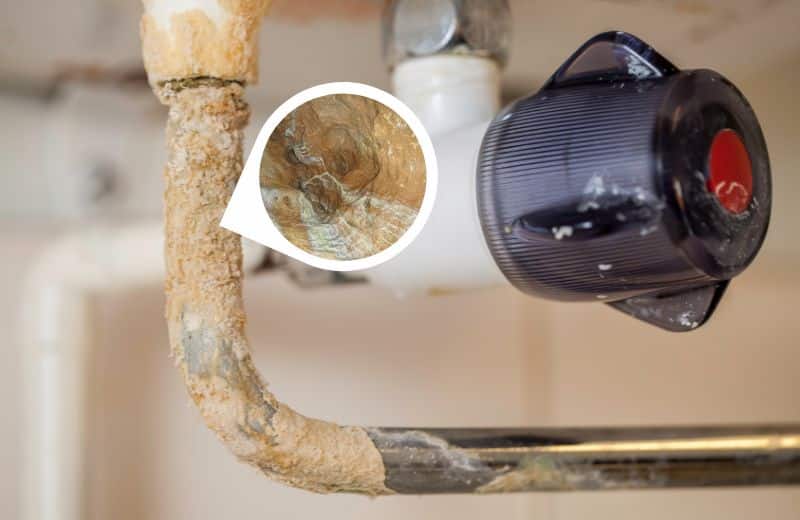
⛔️ Risks of Extremely High or Low TDS Levels
Both extremely low and high TDS levels can have adverse health effects. A low TDS level may indicate low mineral content.
Minerals are essential for overall health, however soft water is not necessarily bad for your health. However, as mentioned a high TDS level may indicate there may be harmful contaminants in the water so its best to avoid excess consumption of high TDS in drinking water.
So, how much TDS level is appropriate for overall health? Generally 50-300 ppm (tap water) is safe for human consumption.
📤 How Can I Reduce TDS in My Water?
These are the best methods that we use to reduce TDS in our drinking water.
Install a Reverse Osmosis System
Reverse osmosis has a TDS rejection rate of 92-98%, so it’s a great option for lowering the TDS levels of your drinking water.
How it Works
The RO process works by sending water through several filters and an RO membrane, which has tiny pores that reject the majority of TDS in water The reject impurities are flushed down the drain along with some wastewater.
This water treatment process can remove nearly all impurities and reduce TDS levels, including toxic metals and semi-metals such as copper, nitrate, lead, and arsenic, chemicals, chlorides, salt molecules, magnesium and calcium carbonate, and microorganisms such as bacteria.
Point-of-use RO systems, like under-sink systems and countertop units, are the most commonly used for drinking water treatment at home.
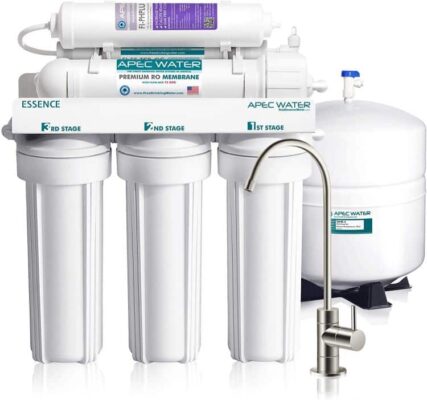
The Evidence
- The EPA recommends reverse osmosis as a “proven technology” for treating water that contains mixtures of contaminants.
- We’ve tested numerous RO systems, and most reduced our water’s TDS by at least 85%. For example, the AquaTru countertop RO system reduced our TDS down to 12 PPM, and the Waterdrop G3 P800 reduced TDS down to 15 PPM – pretty much as close to 0 as it gets.
RO systems are effective in treating high levels of TDS in the water, but excessive magnesium and calcium minerals may damage the RO membrane.
👨🔧 Related: How Does a Reverse Osmosis System Work?
Buy A Countertop Water Distiller
Distillation, like RO, can remove virtually all total dissolved solids from drinking water, including calcium carbonate and magnesium, inorganic salts, chloride molecules, nitrate, lead, and other undesirable dissolved solids.
You can use a countertop water distiller system to distill your drinking water at home.
How it Works
During the water distillation process, heat is applied to water, causing it to boil until it evaporates. The water vapor then condenses back into its liquid form in a separate container.
Water has a boiling point that’s lower than most suspended impurities, so most total dissolved solids are left behind when the water evaporates. The few TDS that s\ucceed in evaporating and condensing with water are trapped in a carbon filter in the distiller’s spout.
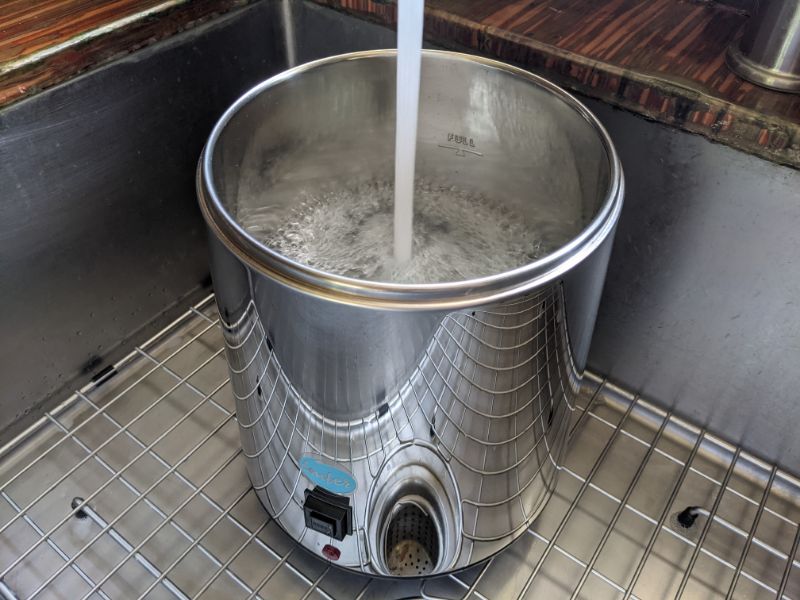
The Evidence
- A 2019 study on the water quality produced by solar distillation noted that this method reduced TDS in drinking water down to 13 PPM and gave the “best results” among all the tested samples.
- The EPA lists water distillers as an effective solution for removing “chloride, total dissolved solids, and other inorganic substances”.
Water distillers don’t give on-demand access to water – they typically produce 1-gallon batches of water in a process that takes around 4-6 hours.
👨🔧 Related: Purified vs Distilled Water
Other Water Treatment Processes
There are a couple of other processes that can be used to reduce TDS in mineral water: deionization and electrodialysis.
However, these processes are less commonly used in domestic water treatment systems, so we don’t generally recommend them as methods of treating high-TDS water at home.
📑 Final Word
We hope we’ve now covered everything you wanted to know about total dissolved solids in drinking water.
Remember, water isn’t definitely unsafe for human consumption if it has a high TDS concentration. But because TDS is a reflection of water quality, higher TDS levels may indicate high levels of certain contaminants with health effects.
The only way to know for certain is to test your water to find out which specific contaminants it contains.
❔ FAQs
Is low-TDS water harmful?
No, low-TDS water isn’t harmful to your health. Low-TDS water is simply pure water that’s lacking in total dissolved solids. The Water Quality Association (WQA) reported that there have been no studies that specifically look at the possible health effects of drinking water with low TDS.
You may find the taste of low-TDS water unpleasant because it doesn’t contain any healthy minerals that contribute to alkalinity. Also, make sure to get plenty of trace minerals in your diet if you switch to low-TDS water.
What is a healthy amount of TDS?
A healthy concentration of dissolved solids in water is anything within the EPA’s secondary advisory level of 500 PPM. A TDS level in the range of 50-150 PPM is ideal, providing the taste benefits of dissolved minerals with less of a risk of certain unwanted impurities being present in dangerous concentrations.
Is TDS a good measure of water quality?
Yes, TDS is a good measure of water quality because it provides an insight into the concentration of impurities collectively present in the water. High TDS suggests poorer water quality because there may be certain dissolved solids that are present in unhealthily high concentrations. But the only way to properly understand your water quality is to test your water for specific contaminants.
What level of TDS is hard water?
Hard water isn’t measured in TDS; it’s measured in PPM (parts per million) or GPG (grains per gallon). You can’t use TDS as a determiner of water hardness because there are hundreds of contaminants that contribute to TDS, not just calcium and magnesium minerals. Water with 7-10+ GPG or 120+ PPM of hardness is generally considered hard.
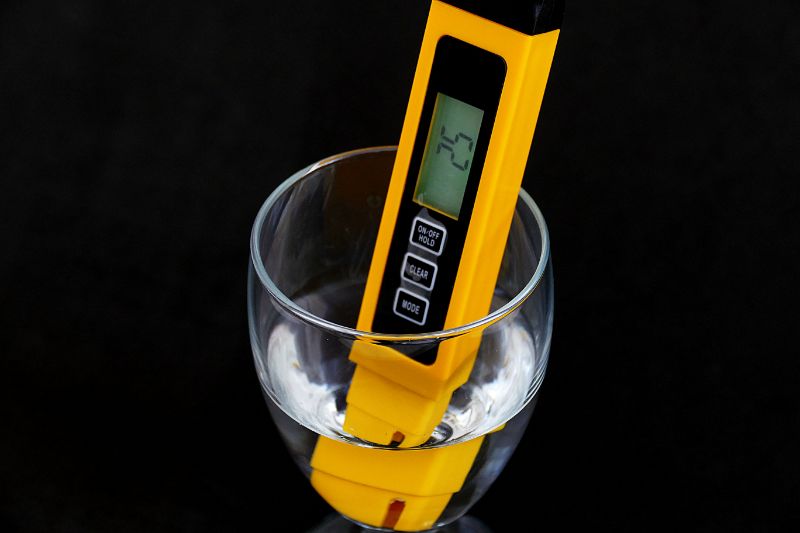
Does boiling water remove TDS?
No, boiling water won’t remove TDS – or it might reduce TDS slightly, but not enough to be worth doing. Most dissolved solids present in water can’t vaporize when water is heated, so all that will happen is that some of the water will evaporate, so you’ll end up with the same concentration of TDS in a smaller batch of water.
Is 30 TDS Safe for Drinking Water?
A low TDS level like 30 ppm likely means that it has a low mineral content, however this does not mean it is unsafe for drinking.
Is it Safe to Drink 250 TDS water?
There is no harmful effects of drinking a 250ppm TDS level. Ideally, drinking water is less than 300ppm. It is important to note that higher TDS levels indicate a water hardness and be can hard on your household appliances and pipes.
